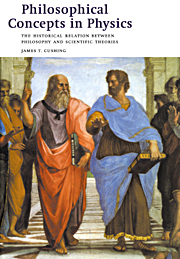 Philosophical Concepts in Physics
Philosophical Concepts in Physics Book contents
- Frontmatter
- Contents
- Preface
- Copyright acknowledgments
- PART I The scientific enterprise
- PART II Ancient and modern models of the universe
- PART III The Newtonian universe
- PART IV A perspective
- PART V Mechanical versus electrodynamical world views
- PART VI The theory of relativity
- PART VII The quantum world and the completeness of quantum mechanics
- PART VIII Some philosophical lessons from quantum mechanics
- 22 The EPR paper and Bell's theorem
- 23 An alternative version of quantum mechanics
- 24 An essential role for historical contingency?
- PART IX A retrospective
- Notes
- General references
- Bibliography
- Author index
- Subject index
22 - The EPR paper and Bell's theorem
Published online by Cambridge University Press: 05 June 2012
- Frontmatter
- Contents
- Preface
- Copyright acknowledgments
- PART I The scientific enterprise
- PART II Ancient and modern models of the universe
- PART III The Newtonian universe
- PART IV A perspective
- PART V Mechanical versus electrodynamical world views
- PART VI The theory of relativity
- PART VII The quantum world and the completeness of quantum mechanics
- PART VIII Some philosophical lessons from quantum mechanics
- 22 The EPR paper and Bell's theorem
- 23 An alternative version of quantum mechanics
- 24 An essential role for historical contingency?
- PART IX A retrospective
- Notes
- General references
- Bibliography
- Author index
- Subject index
Summary
When it was first put forward, special relativity struck many people as counterintuitive and possibly inconsistent, as we saw when we considered the twin paradox in Chapter 17. Quantum mechanics had a similar effect, only to a much greater and longer lasting degree, from the time of its inception in the mid 1920s until the present. This reaction to quantum theory was not confined to an initial confusion that often accompanies a new subject, but remained a life-long puzzle for Einstein, to mention only the most prominent opponent of what he took to be the reigning orthodoxy. In this chapter we study a famous attempt by Einstein and two of his colleagues to show that quantum mechanics was, if not logically inconsistent, then at least an incomplete theory. This charge of incompleteness is just that raised by Schrödinger's cat paradox (Section 21.4).
THE EPR PARADOX
In 1935 Einstein, Boris Podolsky (1896–1966) and Nathan Rosen (1909–1995) (hereafter referred to as EPR) published a paper titled ‘Can Quantum-Mechanical Description of Physical Reality Be Considered Complete?’. They take as their criterion for the completeness of a theory that it contains terms corresponding to every relevant entity found in reality. For example, in the classical description of a system, such as a planet going around the sun, there are symbols representing the position r, the momentum p and so forth for the various parts of the system.
- Type
- Chapter
- Information
- Philosophical Concepts in PhysicsThe Historical Relation between Philosophy and Scientific Theories, pp. 319 - 330Publisher: Cambridge University PressPrint publication year: 1998
